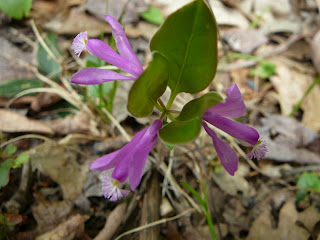5.31.12 We are very fortunate in Dummerston to have both Mountain Laurel and Sheep Laurel or Lambkill. Members of the Kalmia family, they are distinguishable by the placement of flowers: the smaller and more intensely-colored Sheep Laurel flowers are clustered around the stem with a tuft of leaves above them. Both of these shrubs contain toxins that can be fatal if eaten. The pollen is not poisonous to bees, but honey produced from these flowers can be toxic to humans.
Yellow Rattle (Rhinanthus crista-galli) has an inflated seed pod where the seeds rattle around when dry. The little yellow flower petals are beak-like at the top of the pod.
Rattlesnake Weed (Hieracium venosum) also grows in the shallow soils of this acidic environment. The striking contrast of the maroon-red veining on the dark green basal leaves is the most eye-catching part of this plant. The branched flower stalk shoots up a foot or more, and bears 3/4- inch rayed yellow flowers much like Hawkweed, to which it is related.
Welcome
To all those interested in the natural world. Please add your sightings.
In the woods we return to reason and faith-Emerson
Best-Lynn
In the woods we return to reason and faith-Emerson
Best-Lynn
Thursday, May 31, 2012
Wednesday, May 30, 2012
Sunday, May 27, 2012
5.27.12 This imposing five foot specimen of Carrion flower (Smilax herbacea) was attracting the attention of a variety of insects when I was there today. Aptly named for its odor, it is not a plant that one would select to plant at their front door!
The small yellow-green blossoms of Indian Cucumber Root (Medeola virginiana) dangle beneath the upper whorl of leaves on this tiered plant. Its spreading maroon styles give the flower a spidery appearance. The root is said to be cucumber-flavored.
Mountain Laurel (Kalmia latifolia) is starting to bloom - they will last a few weeks, but be sure to schedule a walk among them soon!
The small yellow-green blossoms of Indian Cucumber Root (Medeola virginiana) dangle beneath the upper whorl of leaves on this tiered plant. Its spreading maroon styles give the flower a spidery appearance. The root is said to be cucumber-flavored.
Mountain Laurel (Kalmia latifolia) is starting to bloom - they will last a few weeks, but be sure to schedule a walk among them soon!
Friday, May 25, 2012
5.25.12 Earthstar and Grouse
5.25.12 Clucking and scolding in the underbrush drew my attention, but I was surprised when the female grouse came into the open to herd her scurrying chicks out of sight. I observed only three, but it seemed that I missed several of the fluffy, tan-colored young. This Earthstar fungus seemed to be solitary in the sandy soil. The round spore case has opened to disperse the spores, leaving a flattened grayish shell inside the star-like rays.
Wednesday, May 23, 2012
Monday, May 21, 2012
Saturday, May 19, 2012
Thursday, May 17, 2012
Tuesday, May 15, 2012
5.15.12 Lichens in bloom
In Spring, when there is an abundance of moisture and before temperatures get too hot, lichens are most colorful. British Soldiers, also known as Matchstick Moss, (Cladonia cristatella), are named for their colorful fruiting body which was thought to resemble the uniform of the British Redcoats. Pink Earth Lichen (Dibaesis baeomyces), resembling French knots in embroidery, are those little pink growths on rock or among mosses. Lichens are an unusual combination of two life forms: a fungus and an alga. The fungus (mycobiont) forms the primary structure of the lichen: it anchors it to the substrate and absorbs water and minerals from the environment. The alga (photobiont) is the colorful top structure which is the fruiting body. Both of these lichens formed colorful designs on dark rock backgrounds. These slow-growing structures are very fragile and easily destroyed. In summer, they dry up and go dormant, waiting for a wetter period season when the fungus can absorb water and growth can resume.

5-15
Last night this fellow rambler appeared unexpectedly on my doorstep. As my residence has neither food not shelter suitable to salamander needs, I sent this silent, rain-loving soul back out into the dark and drizzle.
It was a Jefferson's salamander doing its vital - if inexplicable - salamander duties; life and death matters known only to itself.
The world is well-peopled with such mysterious, seldom encountered individuals. Chance gives glimpses of that truth to a lucky few.
John
Sunday, May 13, 2012
5.13.12 Flowers and Wildlife
5.13.12 What started out to be a normal walk on a beautiful sunny afternoon turned up some surprises. First, I encountered my first Blue-eyed Grass of the season. As I rose up from a crouched position where I'd been examining the purple dots on every blade of blue-eyed grass and started to turn around, I was startled to see a raccoon, also in a crouched position, not 15 feet away! Knowing that finding wild animals like this out in mid-afternoon can be a sign of illness, I backed away slowly, keeping a steady eye on the animal. It continued to remain frozen in that position, perhaps as surprised as I had been that the crouched form it had been watching turned into a moving two-legged creature. Nonetheless, I continued my backward exit strategy until the raccoon waddled off into the vegetated tangle.
About to come home, I found several Starry False Solomon's seal in blossom; the plants varied from 2 inches to more than a foot in size, each with a blossom appropriate to its size. Just below my house (this time in the car!) a bob cat darted across the road and paused briefly in the open woods and looked back over its shoulder.
About to come home, I found several Starry False Solomon's seal in blossom; the plants varied from 2 inches to more than a foot in size, each with a blossom appropriate to its size. Just below my house (this time in the car!) a bob cat darted across the road and paused briefly in the open woods and looked back over its shoulder.
Friday, May 11, 2012
Moccasin Flower and Gaywings (Fringed Polygala)
5.11.12 I'm wild about finding orchids in the wild - so today's walk was exquisitely satisfying. The Moccasin Flower or Pink Lady's Slipper is the showiest of the orchids in Dummerston. Orchids are really specific about growing conditions; their spaghetti-like roots lack root hairs, so they are completely dependent on the presence of a mycorrhizal soil fungus which allows them to absorb soil nutrients. Pollinated by bees, only a few of their powdery seeds find the necessary soil requirements for them to germinate. Then it takes at least two years before they flower. Transplanting or disturbing them usually is disastrous.
We also found Fringed Polygala aka Gaywings (Polygala paucifolia) in bloom today. These bright pink/purple little flowers sport two petals, the "wings" at the sides of the fringed tube that contains the reproductive parts of the flower. Members of the Milkwort family, they are often are mistaken for orchids.
We also found Fringed Polygala aka Gaywings (Polygala paucifolia) in bloom today. These bright pink/purple little flowers sport two petals, the "wings" at the sides of the fringed tube that contains the reproductive parts of the flower. Members of the Milkwort family, they are often are mistaken for orchids.
Thursday, May 10, 2012
Wednesday, May 9, 2012
Alien Shrubs in bloom
5/09.12 Although the rain had stopped some hours earlier, raindrops lingered on plants in the still, cloud-heavy air. Even though wet, bumblebees were attracted by the perfume of alien shrubs. Side by side, both the pink and the white Tartarian Honeysuckles and Autumn Olive with its bell-shaped blossoms and silver-white-backed leaves made a bold statement on a steep bank.
Tuesday, May 8, 2012
Monday, May 7, 2012
Red Admiral Butterflies
5.07.12 Yesterday and today, numerous Red Admiral Butterflies flitted from one bright dandelion bloom to the next. I didn't observe them stopping to feed on any other color or type of blossom.
Sunday, May 6, 2012
5.06.12 Spring Treats
I always look for Baltimore Orioles when the apple trees are in bloom. They didn't fail me! This afternoon, I spotted that glowing orange and black ducking around in the quince bush, seemingly trying to hide among the bright pink-orange blossoms. The quince also attracted my first-of-the-year Ruby-throated Hummingbird. The Oriole moved on to the pink-and-white profusion of an apple tree.
Earlier, I nearly mistook a Black-capped Chickadee for a hummingbird: perched on a branch of the plum tree, it was fanning its wings at the speed of a hovering hummingbird - until it took off in pursuit of another chickadee in the orchard.
Earlier, I nearly mistook a Black-capped Chickadee for a hummingbird: perched on a branch of the plum tree, it was fanning its wings at the speed of a hovering hummingbird - until it took off in pursuit of another chickadee in the orchard.
Friday, May 4, 2012
5.04.12 Wetland Wanderings
This afternoon's meander took in two marshes and a brook. Marsh Marigolds (Caltha palustris), a member of the Buttercup family, grow in shallow water. The shiny yellow "petals" (actually sepals) resemble the bright yellow petals of true buttercups. The red eft, the terrestrial stage of the Eastern Newt, are often out after a rain when the forest floor is moist. Foamflower aka False Miterwort (Tiarella cordifolia) is at the height of bloom now with each flower in the cluster extending long stamens. It grows in a variety of conditions, but it is most plentiful where the soil is somewhat wet. The Miterwort (Mitella diphylla) was growing on a gravelly 'island' in a small stream. The flowers are spaced along the stem; their special feature, the snowflake-like fringe on the lip of the tiny (3/16 inch) flower, is easy to miss.
Subscribe to:
Posts (Atom)


















































